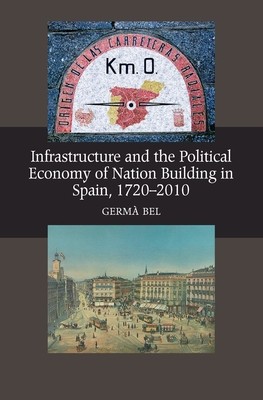
- We will send in 10–14 business days.
- Author: Germa Bel
- Publisher: Sussex Academic Press
- ISBN-10: 1845195329
- ISBN-13: 9781845195328
- Format: 15.2 x 22.9 x 1.1 cm, minkšti viršeliai
- Language: English
- SAVE -10% with code: EXTRA
Infrastructure and the Political Economy of Nation Building in Spain, 1720-2010 (e-book) (used book) | bookbook.eu
Reviews
Description
This book sets out to explain the very particular characteristics of Spanish infrastructure policy. The capital city of Madrid plays a central role: it not only achieved status as the economic capital of Spain in recent decades, but, together with its status as the administrative and political capital, Madrid has become the absolute capital. The challenge is to understand why such development has taken place. First, radial policies in transport infrastructure, which were primarily subordinate to political and administrative objectives, could not be supported by the dynamics of economic activity. For that reason, these policies demanded the use of extensive budgetary resources in the form of subsidies and grants that made possible what legislation alone could not achieve. Additionally, these policies respond to a regular and continuing historical pattern in Spanish politics, which began with the accession to the Spanish Crown of the Bourbon dynasty in the early 18th century. The new dynasty tried hard to translate into practice the vision of building a 'Nation like France, with a Capital like Paris.' The enduring strength of this historical pattern allows us to understand why infrastructural policies in Spain today are so unique and different from those of surrounding and comparable countries. Originally published to great acclaim in Spanish and Catalan, author Germ Bel places the historical development in a contemporary perspective in discussing the Spanish enthusiasm for a high-speed railway, with the prospect of Madrid being connected with all provincial capitals (albeit while freight by train has been neglected); a fully centralized model of airport management that is unmatched among comparable countries; and a mixed (toll and toll-free motorways) and highly asymmetric territorial highway funding model for motorways.
EXTRA 10 % discount with code: EXTRA
The promotion ends in 22d.03:23:36
The discount code is valid when purchasing from 10 €. Discounts do not stack.
- Author: Germa Bel
- Publisher: Sussex Academic Press
- ISBN-10: 1845195329
- ISBN-13: 9781845195328
- Format: 15.2 x 22.9 x 1.1 cm, minkšti viršeliai
- Language: English English
This book sets out to explain the very particular characteristics of Spanish infrastructure policy. The capital city of Madrid plays a central role: it not only achieved status as the economic capital of Spain in recent decades, but, together with its status as the administrative and political capital, Madrid has become the absolute capital. The challenge is to understand why such development has taken place. First, radial policies in transport infrastructure, which were primarily subordinate to political and administrative objectives, could not be supported by the dynamics of economic activity. For that reason, these policies demanded the use of extensive budgetary resources in the form of subsidies and grants that made possible what legislation alone could not achieve. Additionally, these policies respond to a regular and continuing historical pattern in Spanish politics, which began with the accession to the Spanish Crown of the Bourbon dynasty in the early 18th century. The new dynasty tried hard to translate into practice the vision of building a 'Nation like France, with a Capital like Paris.' The enduring strength of this historical pattern allows us to understand why infrastructural policies in Spain today are so unique and different from those of surrounding and comparable countries. Originally published to great acclaim in Spanish and Catalan, author Germ Bel places the historical development in a contemporary perspective in discussing the Spanish enthusiasm for a high-speed railway, with the prospect of Madrid being connected with all provincial capitals (albeit while freight by train has been neglected); a fully centralized model of airport management that is unmatched among comparable countries; and a mixed (toll and toll-free motorways) and highly asymmetric territorial highway funding model for motorways.


Reviews